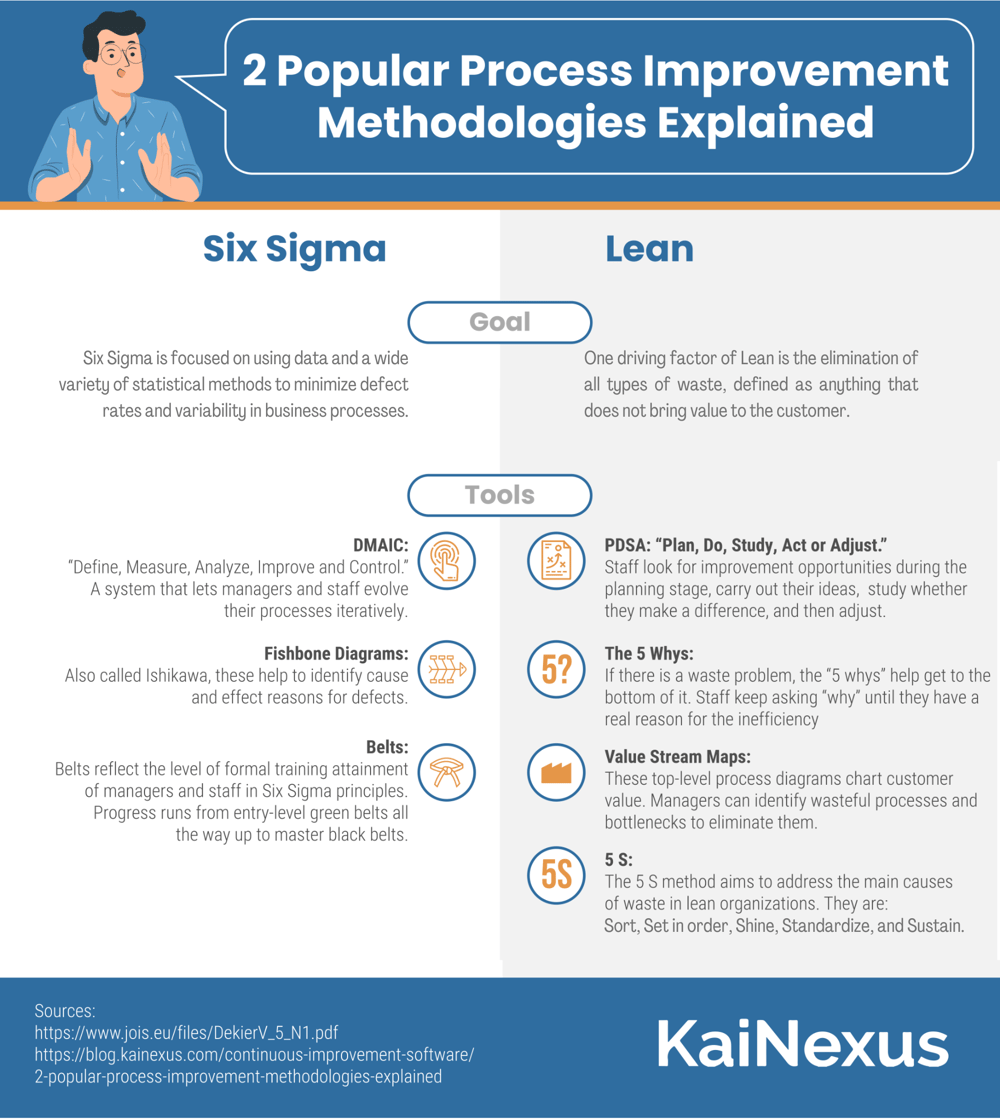The world’s most successful organizations are relentless in their quest for flawless processes and perfect execution. The ability to reliably produce quality outcomes with minimal waste is elusive but achievable with the right leadership and attention. That’s why many organizations turn to proven process improvement methodologies and techniques.
This post will give you an introduction to two of the most effective and popular. We’ll cover some of the most important tools associated with each methodology, but keep in mind that there is a lot of crossover, with many companies incorporating tools from each of the methods.

Six Sigma
Six Sigma was developed at Motorola and eventually became part of the core strategy at General Electric. It is closely associated with manufacturing but is used by organizations of all types. The main goal of Six Sigma to minimize defect rates and variability in business processes. For a process to be “Six Sigma,” it must have fewer than 3.4 defects out of 1 million opportunities. In other words, it has to be almost perfect.
One key innovation of Six Sigma is "professionalizing" of quality management functions. Six Sigma specialists, whether it's part of their duties or a full time role, often take on big challenges for an organization, engaging others in the formal improvement process.
Six Sigma is focused on using data and a wide variety of statistical methods to improve process efficiency and reduce variations. Therefore, many of the tools used by practitioners are measurement-oriented.
DMAIC - The tool most closely associated with Six Sigma is DMAIC, which stands for Define, Measure, Analyze, Improve, and Control. Improvement projects in Six Sigma go through this process, which is continually repeated as the process gets nearer to perfection.
Fishbone Diagrams - Fishbone diagrams (also called Ishikawa diagrams) are another way to understand cause-and-effect to find the reasons for defects. The diagram resembles a fishbone with the head representing the problem and lines branching out into different categories of potential causes. They typically include people, processes, equipment, environment, materials, and management. These diagrams are also used in the practice of Lean (since fishbone diagrams pre-date both Lean and Six Sigma!)
"Belts" - Six Sigma is known for its formal training and certification process that bestows "belts" on those who have reached certain levels of knowledge and experience. The classic progression goes from Green Belt, to Black Belt, to Master Black Belt, although many organizations and certifying bodies have added other colors to represent more introductory knowledge. Belts sometimes also appear in the combined "Lean Six Sigma" methodology.
Lean (Also called Lean Manufacturing, or Lean Thinking)
While the focus of Six Sigma is on eliminating defects, one driving factor of Lean is the elimination of all types of waste, defined as anything that does not bring value to the customer. There is a synergy between Lean and Six Sigma, given that defects certainly represent one form of waste. Some companies combine elements of each approach, as "Lean Sigma" or "Lean Six Sigma."
The Lean approach calls out eight different types of waste: excess inventory, unnecessary transportation, over-processing, overproduction, waiting, unnecessary movement, defects, and untapped human potential. Process improvement is focused on eliminating as much waste as possible. The tools and mindsets used to achieve that end include:
PDSA: PDSA is an improvement cycle similar to DMAIC. It stands for Plan, Do, Study, Act (or Adjust). It begins with the Standardized Work, or the current best practice for any process or task. Improvement teams study opportunities for improvement during the Plan stage. Next, they implement (Do or test) corrective actions that may solve problems or get better results. They then Study the situation and the data to see if the change was, in fact, an improvement. If so, they formalized the new Standard Work. The cycle can then begin again. Or, we can Adjust -- meaning we can adapt, abandon, etc. depending on the results.
The 5 Whys - One hallmark of Lean is that the root cause of any defect or problem process must be identified and corrected. The 5 Whys is a technique for digging deeper into a problem even though a surface issue may appear to be the cause of the problem. Users start with a problem statement and then continue to ask why until the underlying issue is revealed and corrected. Pro tip: the number of whys required won't always be exactly five.
Value Stream Maps: These are high-level process diagrams that chart the movement of value to the customer. They help reveal unnecessary tasks, movement, or materials that might be targeted for elimination. They are also used to reveal bottlenecks that may cause the waste of waiting or excess inventory. Unlike a process map, which focuses on what happens, a VSM also highlights time when a product is just waiting between steps. Instead of working faster, we can focus on reducing delays and the waste of waiting.
5 S: Poor workplace organization is a major cause of many of the 8 wastes of Lean. To address it, the 5 S method is used. In English, the five S’s are: Sort (remove any unnecessary materials), set in order (arrange materials so they are easy to access in a timely manner), shine (clean the workspace regularly), standardize (make the previous three S’s a standard routine) and sustain (conduct regular audits and continue improving).
One tool that is shared in common between both approaches is process improvement software. The best solutions can be tuned to support the techniques of either methodology. It provides a platform for collecting opportunities for improvement, organizing the associated projects, and recording results.
Whether your organization adopts one methodology or the other or takes a bit out of column A and column B, the important thing is to think about improvement as a structured, continuous activity that is connected to the success of the organization. These methods are popular and spreading because they work.
![[WEBINAR] A Deep Dive into A3 Thinking](https://no-cache.hubspot.com/cta/default/326641/a78d9f1b-c108-4709-8a9d-9dd5a8a020b3.png)



Add a Comment